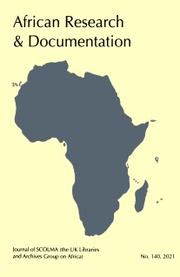No CrossRef data available.
Article contents
Annotated Maps: Charting Research Through Technology
Published online by Cambridge University Press: 25 April 2022
Extract
This paper addresses the long-term preservation and management of priceless library hardcopy resources, by converting them into a digital resource, using the University of Botswana's Okavango Research Institute (ORI) Library map collection as a case study. As libraries in developing countries increasingly adopt digitisation in order to expand ‘safe’ access to their resources, they are often constrained by lack of funds to acquire the necessary Information and Communication Technology (ICT) infrastructure and recruit skilled personnel who can successfully develop, implement, host and manage such projects. Rather than striving to gather all the resources in-house, university libraries may seek external funding through collaboration with other departments or personnel within the same university, external partner organisations that may already have the requisite skills and infrastructure to assist them with bringing their projects to fruition.
- Type
- Articles
- Information
- Copyright
- Copyright © International African Institute 2014
Footnotes
Paper presented at the meeting of SCECSAL XXI, Lilongwe, Malawi. July 28 - August 1, 2014. See ‘SCESAL XXI - a brief summary’, by Birgitte Jansen, ARD 124 (2014), pp. 49-50.


